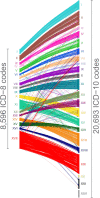A unidirectional mapping of ICD-8 to ICD-10 codes, for harmonized longitudinal analysis of diseases
- PMID: 37555907
- PMCID: PMC10570238
- DOI: 10.1007/s10654-023-01027-y
A unidirectional mapping of ICD-8 to ICD-10 codes, for harmonized longitudinal analysis of diseases
Abstract
Periodic revisions of the international classification of diseases (ICD) ensure that the classification reflects new practices and knowledge; however, this complicates retrospective research as diagnoses are coded in different versions. For longitudinal disease trajectory studies, a crosswalk is an essential tool and a comprehensive mapping between ICD-8 and ICD-10 has until now been lacking. In this study, we map all ICD-8 morbidity codes to ICD-10 in the expanded Danish ICD version. We mapped ICD-8 codes to ICD-10, using a many-to-one system inspired by general equivalence mappings such that each ICD-8 code maps to a single ICD-10 code. Each ICD-8 code was manually and unidirectionally mapped to a single ICD-10 code based on medical setting and context. Each match was assigned a score (1 of 4 levels) reflecting the quality of the match and, if applicable, a "flag" signalling choices made in the mapping. We provide the first complete mapping of the 8596 ICD-8 morbidity codes to ICD-10 codes. All Danish ICD-8 codes representing diseases were mapped and 5106 (59.4%) achieved the highest consistency score. Only 334 (3.9%) of the ICD-8 codes received the lowest mapping consistency score. The mapping provides a scaffold for translation of ICD-8 to ICD-10, which enable longitudinal disease studies back to and 1969 in Denmark and to 1965 internationally with further adaption.
Keywords: Conversion table; Crosswalk; Data harmonization; Denmark; Diagnosis; Disease codes; ICD-10; ICD-8; International classification of diseases; Mapping.
© 2023. The Author(s).
Conflict of interest statement
The authors have no relevant financial or non-financial interests to disclose.
Figures





References
-
- World Health Organization. [Cited: 6 Feb 2020] https://www.who.int/classifications/icd/en/.
-
- World Health Organization . Manual of the International Statistical Classification of Diseases, Injuries, and Causes of Death. Geneva: World Health Organization; 1977.
-
- World Health Organization. International statistical classification of diseases and related health problems, 10th revision, Instruction manual. 2016. Vol. 2. Fifth edition.
-
- World Health Organization. ICD-11 Implementation or transition guide. 2019.
Grants and funding
LinkOut - more resources
Full Text Sources

